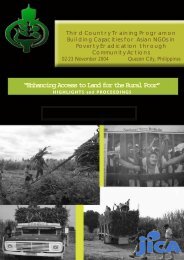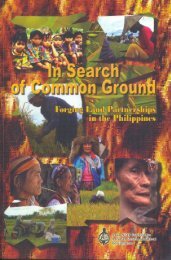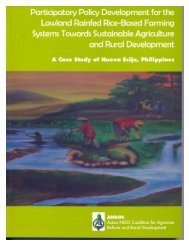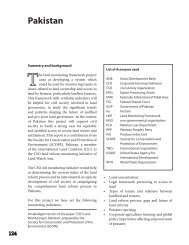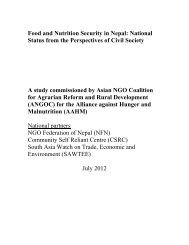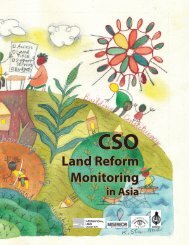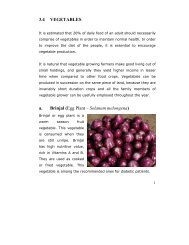Traditional Practices in Agriculture FULL - ANGOC Site
Traditional Practices in Agriculture FULL - ANGOC Site
Traditional Practices in Agriculture FULL - ANGOC Site
You also want an ePaper? Increase the reach of your titles
YUMPU automatically turns print PDFs into web optimized ePapers that Google loves.
Parasitic Insects: These are usually small flies or wasps, which<br />
attack one or a few closely, related pest species. They are parasitic<br />
<strong>in</strong> their larval stages but free-liv<strong>in</strong>g as adults.<br />
Tach<strong>in</strong>id Flies, Braconid Wasps: Complete their life cycle on<br />
<strong>in</strong>sect pests. They usually attack the egg of the host pest or the<br />
caterpillar by lay<strong>in</strong>g an egg <strong>in</strong>to its body. The wasp larva hatches<br />
<strong>in</strong>side the caterpillar body and feeds on it.<br />
Trichogramma Spp: Attacks eggs of butterflies and moth. This<br />
wasp<br />
produces very few side effects on beneficial <strong>in</strong>sects.<br />
Epid<strong>in</strong>ocarsis Lopezi: Feeds and reproduces on mealy bugs of<br />
cassava. It has the ability to establish itself <strong>in</strong> cassava fields<br />
Encourag<strong>in</strong>g Predators<br />
In nature, pests are usually controlled by the pressure of <strong>in</strong>sect<br />
predators and parasites which keep the populations of the harmful<br />
<strong>in</strong>sects under control. Most of the <strong>in</strong>sects <strong>in</strong> nature are either<br />
beneficial or at least harmless. There are many ways to encourage<br />
<strong>in</strong>sect predators <strong>in</strong> one’s garden.<br />
1. Create A Suitable Habitat For Insect Predators: Flower<strong>in</strong>g<br />
shrubs and trees throughout the garden will attract many beneficial<br />
<strong>in</strong>sects, <strong>in</strong>clud<strong>in</strong>g parasitic wasps which require pollen and nectar<br />
for their growth and maturity. Plants belong<strong>in</strong>g to Umbelliferae



